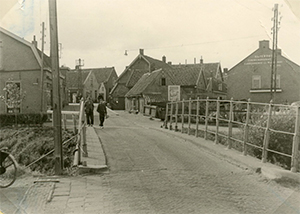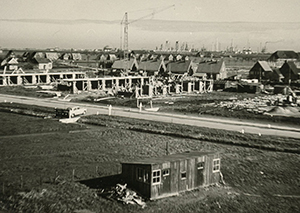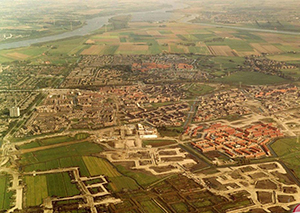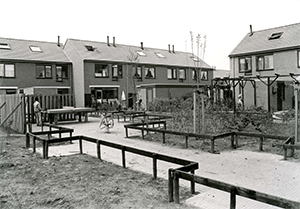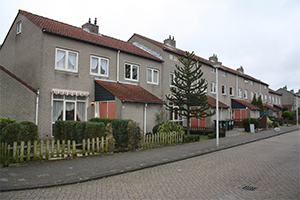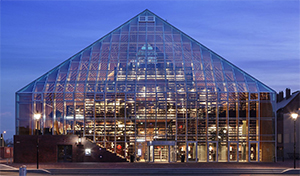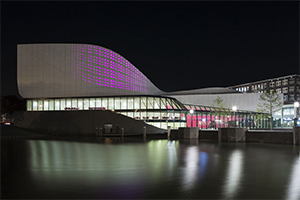The resentment of populations throughout Europe towards their governments, politics and politicians has led to the misconception of the migrants being a reason for the breakdown between government citizens. How can we reshape the relationships between governments and citizens with migrants as a valued resource for our communities? The result of the lab will be ideas and initiatives realized by citizens with migrant and non-migrant backgrounds addressing the question: how can New Towns become places of participation and real influence for their inhabitants?
Historical introduction
Spijkenisse is situated southwest of Rotterdam in the Rhine-Meuse delta. Since 2015 the new town is part of the municipality Nissewaard. The municipality has a population of 85.000 inhabitants, of which about 73.000 live in Spijkenisse.
The period pre-WWII
Spijkenisse was founded as an agricultural and fishing community along an inlet of the Old Meuse. A residential dike emerged on the north shore, the present Voorstraat. The houses, crofts and church that surrounded it, evolved into a village. The medieval Dorpskerk (‘Village church’) and the market square still exist today, as does the windmill on the Noordeinde (‘Northend’). After the second World War the village had a modest scale of about 3.000 inhabitants, but from the 1960s onwards the town grew quickly to the present size. Until the middle of the twentieth century the population was composed out of craftsmen and farmers from families that had lived in Spijkenisse and in the direct surroundings for centuries. Spijkenisse is located on an island which until 1903 was isolated. The result was very few economic activity and residential exchange from and to the island. It was only after the construction of the Spijkenisser bridge that the population became a little more diverse.
The years 1960s
In the 1960s Spijkenisse goes through its first growth spurt caused by its location in relation to the westwards expanding port of Rotterdam and the decision of the municipality to facilitate the development of the port. Many working Rotterdammers settled in Spijkenisse to live closer to their work. In this period Spijkenisse develops with a quite high pace from a village to a small town of 25.000 inhabitants in 1973. In this period the composition of the population knows the first radical change: the ’original’ Spijkenisser of the village got almost completely absorbed by the ’new’ Spijkenisser population.
Groeikern-era
In 1977 the municipality accepted the national status of groeikern (‘growth town’) increasing its target. This meant 16.500 new homes had to be built within a period of fifteen years. The state provided funding to extend the Rotterdam metro to Spijkenisse, under the condition that the largest part of the housing stock had to be realized within a certain proximity to the metro stations. The planning concept behind the new housing developments was the creation of single family homes with private gardens, while high rise buildings were out of question, leading to high density neighbourhoods. Owner-occupied and social rental dwellings were fully mixed. The dwellings were for the largest part occupied by home seekers from Rotterdam, Schiedam and Vlaardingen. It’s still the middle-income families, often employed in the harbor, that move to Spijkenisse. In the 1980s the population grew to almost 70.000 inhabitants.
After the growth
The high building pace, high density, absence of high rise and the economic crisis of the 1980s contributed to the monotonous urban landscape we know today. Despite the fact that the growth did not directly create an urban atmosphere, Spijkenisse had to deal with increasing ‘urban problems’. Although one could say that Spijkenisse was living an identity crisis (village or city), inhabitants affectionately started calling their hometown ‘Spikecity’. After this period the population grew a little further before it stabilized. Spijkenisse started struggling with the middle-class residents leaving and a lower-class residents moving in and reacted with the construction of more expensive housing. The composition of the population at that point became more heterogeneous.
In the 21st century Spijkenisse changes its course again. After decades of growth and housing development, the focus is now shifting from quantity to quality and the municipality is determined to improve the anonymous image of the town. Large investments are made in the town centre, high-end cultural facilities drive the regeneration of some of the older neighbourhoods and the construction of more expensive housing stocks. It is seen as necessary to stay attractive for middle class residents.
TOPICAL ISSUES
Positioning in the region
New towns in the Netherlands have been developed to unburden the pressure on the large cities and to make sure that the suburbanisation would develop in a structural manner. Presently these large, historical cities have become more appealing and more popular again. Suburbanization is no longer always self-evident. Through the years, the regional development has changed the territorial organisation and the relation between Rotterdam and its suburban poles. The region is more urbanized, transport systems have been extended and the economic structure has changed.
When new towns responded to the only need of providing new houses, people moved in, wherever the town was built. But the situation is different now. Labour economy in the industrial areas has changed as well. People no longer get a house, but they choose where they want to settle with increased awareness. Other towns in the region have also built suburban settlements with the consequence that the existing housing supply has lost appeal. Because of that, and because of the changed economy, the higher middle class has been replaced by a lower middle class.
As a result of all this, we should think about defining our new function in the region. In what way do we want to position ourselves? What is our unique selling point?
In Nissewaard, we keep positioning Spijkenisse as a residential area for families. Because we are situated close to, yet not attached, to the agglomeration of Rotterdam, we create a distinct profile for ourselves as a green large residential area, on the border of the Rotterdam region and the rural area of the province of Zeeland. The employment basin of the port of Rotterdam is just around the corner. The economic structure of the port has changed in the course of the time due to automation resulting in a decreasing demand for employees. That change continues, but at the same time, the demand for higher-skilled work-force increases due to the transformation of the port into a green industry. Nissewaard wants to be the safe haven of a world-lead harbour. The transport connections for it are already in place. As a town, we don’t need to be completed (to grow further?). We accept that our inhabitants will continue to visit the centre of Rotterdam, but we would like to encourage them to visit the town centre of Spijkenisse on a regular basis and feel at home there.
The revitalisation of the Town centre
The town centre of Spijkenisse was constructed during the early 1980s and, soon after that, it no longer met with the standards and needs of the visitors. It was designed as a mono-functional space and became unattractive and lacking a nice and welcoming atmosphere. Facilities were meant to serve a much smaller population.
During the past years, a lot of investments have been made in the town centre. The centre has been transformed into the ‘living room’ of the town. The area for shopping, hotels, bars and restaurants has been expanded, building façades and pavements were renewed, and a new theatre and a new library were built. These both have a distinctive architecture and were designed by top-class architects. At the same time, retail is going through a rough time as a consequence of the increased popularity of the online shopping. Together with real estate owners and shopkeepers, we try to increase the residential quality. Initiated by the municipality, a so-called business investment zone was set, in which every owner and every user payan extra tax, serving collective goals. This idea comes from the owners and users of the area who have taken this decision by means of a popular vote.
Identity and culture
Typical for a new town, many of our inhabitants were not born in Spijkenisse. As a consequence, they feel less attached to the town, but it also means that the social and cultural structures are still under-development. We are now at a crucial point: the new generation was born and raised in our city. This generation demands some extra attention. At the same time there is more cultural and industrial heritage than it seems at a first sight. The planned new towns and their inhabitants form a cultural heritage themselves. Culture can also function as an economical booster.
The formerly mentioned new theatre and library have a special architectural value and have become landmarks in the relatively colourless town. This does not only put Spijkenisse on the map, but it also gives the inhabitants something to be proud of. Hopefully it increases their attachment to Spijkenisse. The city marketing is primarily addressing the young people that left during their studies and that are now in the settling down phase during which they form a family.
Sustainability
Due to the fact that Spijkenisse was built in one go and during a very short time span, the built environment gets old all at once. In order to prevent a massive deterioration, timely investments are necessary. In the case of municipal owned parts of the built environment (public space, underground infrastructure, etc.) that seems mostly a matter of a well-balanced financial management. But in the context of the energy transition (from gas to sustainable substitutes) this is a big challenge.
In the case of the housing supply the challenge is even greater. Many dwellings need to be made energy efficient and/ or lifecycle-proof, or – dependent on their quality – to be replaced by more sustainable houses. Both ways also offer the chance to diversify and to improve the aesthetic appeal of the housing supply. In that way the one-sided structure and uniformity of many of our neighbourhoods will be breached. This theme is of extra importance since the attractive living environment has always been one of the most important qualities of Spijkenisse.
Some of the oldest parts of the housing supply in the town have been demolished by the housing associations and have been replaced by something new. A far bigger part of the housing supply, however, is younger than that (the biggest growth of Spijkenisse took place between 1975 en 1985), and more important, owner-occupied. Throughout the years, that part of the housing supply has lost a lot of its attractiveness; a process that was enforced by the use of cheap materials, and planning concepts which by now, are perceived as outdated. Therefore, Nissewaard strongly commits to renew the housing supply in order to make it future-proof. With different measures "we try to trigger investments in order to make our houses and neighbourhoods more attractive, more sustainable and more suitable for an ageing population."
Social policy / ambition
Recently three decentralization acts took place in the Netherlands. Youth health care, participation and social support became responsibility of the municipalities. It was the reason for Nissewaard to apply major changes in its own vision and methods. The basis of the idea is to change the attitude and work and act closer to the citizens instead of the top-down and distant relation which is the usual approach of the governmental system. This for instance means integrated approaches to help inhabitants, both between municipal departments and between the municipality and health care partners. But it also means working more from inside the neighbourhoods. Therefore, the new way of working is called Thuis in de Wijk (‘At Home in the Neighbourhood’).
Facts
Established: during the years 1960s and 1970s
Population: 73.000
Population with a migration background: 24%
Strengths
– Spijkenisse has green and natural values
– Strategic position in the region and close to Rotterdam
– Renewal and Cultural Investments have projected the city into the regional arena
Challenges
– reposition itself in the regional arena and become "multifunctional" in providing services and infrastructures complementary to the port and to the mother city
– become attractive for a more diverse population, including young people and young families
– provide a more varied housing supply and renewal of the existing housing stock
– foster the sense of belonging and a "feel-at-home atmosphere"




